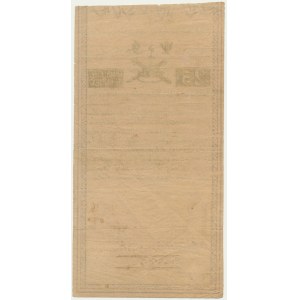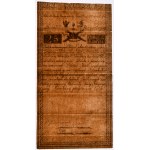Piece printed on a piece of sheet without additional watermark elements.
An interesting piece, in our opinion printed on low-weight paper, i.e. so-called thin paper.
The banknote has numerous bends, and bears traces of minor cleaning, but even despite the mentioned circulation marks, we believe that the limpness and softness of the paper is not only due to the circulation, but primarily to the grammage of the paper used.
Note the low four-digit serial number, which may provide a clue to the grammage of the paper used.
The onion shade of the paper is very well preserved.
A very interesting piece, which we strongly recommend viewing!
In the Polish lands, the introduction of paper money into circulation was connected with expenses related to the outbreak of the Kosciuszko Insurrection. Its issuer was the Directorate of Treasury Tickets established by the Supreme National Council. In terms of value, treasury tickets were equated with coinage. Obligations to the Treasury could be paid a maximum of 50% in paper money and the remainder in coins. This condition resulted in its negative reception by the public. In the future, the redemption of treasury tickets was to be financed from national wealth. For counterfeiting paper money, the death penalty was stipulated, as well as confiscation of all the perpetrator's property. On September 29, 1794, in order to strengthen confidence in treasury tickets, the National Supreme Council authorized the regulation of the entire amount in paper pennies and zlotys. Due to the failures of the uprising, public confidence in paper money was declining. The population preferred to accept bullion money in settlements. The range of issuance of the first Polish paper money was small - it was introduced on a large scale only in Warsaw. After the capture of the capital on November 6, 1794, tickets of all denominations for a total of 7.8 million Polish zlotys remained in the hands of the population.
On June 8, 1794, the Supreme National Council passed a resolution establishing an issuing institution - the Directorate of Treasury Tickets - and introducing treasury tickets in denominations: 5, 10, 25, 50, 100, 500 and 1000 Polish zlotys. Treasury tickets with an issue date of June 8, 1794 are very similar. They are one-sided printings in the form of a standing rectangle differing only in color and border detail. Each denomination was hand-numbered and signed by two or three representatives of the Treasury Ticket Directorate. In addition, each ticket bears the dry seal of the Treasury Ticket Directorate.
After printing, paper money of equal denomination was stapled together in the form of a cloth-bound "booklet." When they were put into circulation, they were hand-cut from them by which tickets of the same denomination differed in size and in the shape of the top edge. The part that remains in the "booklet" and the coin released into circulation have the same number.










